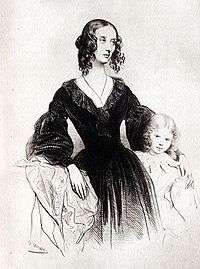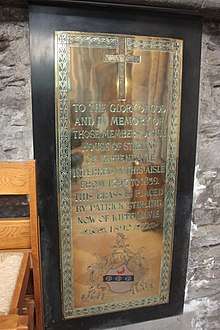Jane Stirling
Jean ("Jane") Wilhelmina Stirling[1][2] (15 July 1804 – 6 February 1859) was a Scottish amateur pianist who is best known as a student and later friend of Frédéric Chopin, two of whose nocturnes are dedicated to her. She took him on a tour of England and Scotland in 1848, and took charge of the disposal of his effects and manuscripts after his death in 1849. While there is no evidence they were lovers, she was often referred to, after Chopin's death, as "Chopin's widow".[3]

Life
Stirling was born Jean Wilhelmina Stirling as the youngest of 13 children of John Stirling of Kippendavie,[4] at Kippenross House, near Dunblane in Perthshire, and was descended from a noble Scottish family.[5][6] Her mother died when she was 12, her father when she was 16. The inheritance made her a wealthy young woman. She was then placed under the charge of her widowed sister, Mrs Katherine Erskine, aged 29. She was popular and very pretty; she was said to have declined over 30 marriage proposals. From 1826, she and her sister divided their social life between Scotland and Paris.[5] She involved herself not only in music and the arts, but also in subjects such as prison reform, homeopathy, and the Protestant movement.[7]
The pianist Lindsay Sloper claimed to have been the one to introduce her to Chopin,[8] perhaps in 1842[7] or 1843.[9] She became his pupil immediately. Chopin does not mention her until 1844.[8] That she was a talented pianist was evident from Chopin's remark to her, "One day you’ll play very, very well."[9] Towards the end of his life he even entrusted one of his own pupils, Vera Rubio, to her tutoring.[9] In 1844 he dedicated his two Nocturnes, Op. 55 to her.[9] She also expressed a desire to learn the cello, and so Chopin referred her to his collaborator, Auguste Franchomme.[5]
Jane Stirling worked with Chopin in assembling seven bound volumes of the French editions of most of his works, and in compiling a thematic index. These volumes were later used by the French musicologist and Chopin biographer Édouard Ganche to establish the Oxford original edition of Chopin.[10] However, whether Chopin intended this collection to serve as a basis for a revised collected edition of his music is an open question.[11] She also became his secretary, agent and business manager. She arranged his concert at the Salle Pleyel on 16 February 1848, and also attended to the heating, the ventilation, and the flowers. The concluding item of the concert was the Barcarole in F-sharp major, but Chopin was too exhausted to complete the final section. After managing to walk unaided to his dressing room, he collapsed in Jane Stirling's arms. This was to prove his final Paris concert.[5] There had been plans for another concert there in March, but on 23 February a revolution broke out, many people fled the city, and Chopin was suddenly deprived of his livelihood.[7]
Jane and her sister suggested that Chopin perform a series of concerts in England. He was ill and did not want to travel, but as he was in need of the money that such a tour would provide for him, he agreed. They left for London on 20 April 1848. Through Jane Stirling he was introduced to the crème of British society.[5] He played at a private function on 15 May which Queen Victoria and Prince Albert attended (but he was never invited to play for them at Buckingham Palace, as is sometimes claimed).[7]
By August, the London season being at an end, he accepted an invitation from Jane Stirling to visit her homeland of Scotland.[3] Near Edinburgh, they all stayed at Calder House, the castle of Lord Torphichen, the ladies' brother-in-law.[9] (Calder House was where in 1556 John Knox had first celebrated communion.[4]) He went on to give a "very select" concert in Glasgow,[12] staying with Stirling's sister Ann at Johnstone Castle. Being dragged from one wealthy relative to another, and from city to city, all the time meeting many people with whom he could not converse (he spoke only French and Polish)[4] only made Chopin's physical condition worse. In Manchester, on 28 August, he played three pieces, but was so weak he had to be carried on and off the stage. All his expenses throughout the tour were paid by Jane.[5] It was during this tour, in late October 1848 in Edinburgh, at the home of Dr Adam Łyszczyński, a Polish physician with whom he stayed for a number of days, that Chopin wrote his last will and testament – "a kind of disposition to be made of my stuff in the future, if I should drop dead somewhere," he wrote to his friend Wojciech Grzymała.[13]
Although she was almost six years older than Chopin (she was born in July 1804, the same month as George Sand), it was generally rumoured at this time that Chopin and Stirling were shortly to be engaged. This never happened; indeed, there is no indication in any of Chopin's letters that he ever felt any amorous feelings for her. On the contrary, she often bored him.[5] He said to a friend, "They have married me to Miss Stirling; she might as well marry death."[6] He referred to both Stirling and Mrs Erskine as "mes braves Écossaises", and was frequently exasperated by their over-solicitude and habit of bringing him religious pamphlets.[14]
His final concert in Britain was on 16 November at London's Guildhall, where he played despite being desperately ill.[5] They returned to Paris on 24 November accompanied by mountainous debts, which Jane Stirling paid anonymously.[15]

During Chopin's last weeks in 1849, Stirling commissioned the Polish artist Teofil Kwiatkowski to produce an oil painting of Chopin, which also included Chopin's sister Ludwika (Louisa) Jędrzejewicz, Marcelina Czartoryska and Grzymała.[5]
In September 1849, Chopin took an apartment at Place Vendôme 12. The second-floor, seven-room apartment had previously housed the Russian Embassy; Chopin could not afford it, but Jane Stirling rented it for him.
A few days before Chopin's death on 17 October, she purchased his grand piano.[9] She paid the total cost of his funeral; all the travelling expenses from Warsaw of Chopin's sister Ludwika; and for his piano to be shipped to her in Warsaw. She purchased all of Chopin's remaining furniture and effects, including his death mask by Auguste Clésinger.[5][16] She had some of the furniture shipped to Calder House near Edinburgh. It was displayed in a special room which became known as the Chopin Museum. She also collected various manuscripts, sketches, letters and other papers of his, containing handwritten comments, variants and dedications. She had a considerable correspondence with Ludwika Jędrzejewicz concerning the posthumous publication of some of his unpublished works, and 25 of these letters are now in the Muzeum Fryderyka Chopina in Warsaw.[9]
Chopin had told Jane Stirling that she was the only one who knew his true date of birth. She wrote it down and placed it in a box which is buried with him in Père Lachaise Cemetery.[7] On the first anniversary of his death she scattered over Chopin's grave some Polish soil that she had obtained from Ludwika.[5]

She studied the piano further under Thomas Tellefsen, himself a Chopin pupil.[9]
Jane Stirling died on 6 February 1859, aged 54, of an ovarian cyst. She was buried on 11 February in the grounds of Dunblane Cathedral.[17] Her will bequeathed the Chopin Museum to Chopin's mother Justyna Chopin. In 1863 much of it was destroyed when the Russian soldiers ransacked Zamoyski palace in Warsaw as a retort for an unsuccessful attempt to assassinate the Russian Namiestnik of Poland (viceroy) Friedrich Wilhelm Rembert von Berg by Polish resistance. One item which still exists is a lock of his auburn hair which Jane had kept.[5]
Biography
The first and only existing biography of Jane Stirling was written by Audrey Evelyn Bone in 1960 by author's private publishing in only 500 copies.[18]
An alternative view: Jenny Lind
It has been claimed that the financial assistance said to have been provided by Jane Stirling and Katherine Erskine was actually from the Swedish soprano Jenny Lind, and that the Scottish sisters were simply a cover for Lind's anonymity. Their father's will left them only £300, which was by no means enough to fund the sort of generosity that was provided to Chopin.[19] However, Jane had property over and above the single payment from the will, as her family were major plantation owners in Jamaica and received considerable compensation in 1831/33 on the abolition of slavery.[20]
Artistic recognition
She was portrayed as a child with her father by Sir Henry Raeburn. The portrait hangs in Fyvie Castle and entitles her Jean Wilhelmina (the more Scottish version of Jane).[21]
References
| Wikimedia Commons has media related to Jane Stirling. |
- Dewar, Peter Beauclerk (7 August 2001). "Burke's Landed Gentry the Kingdom in Scotland". Burke's Peerage and Gentry. p. 14. Retrieved 7 August 2020 – via Google Books.
- "Clan Stirling's own genealogy" (PDF). Clanstirling.org. Retrieved 7 August 2020.
- "Lifestyle | The Scotsman". Scotsman.com. Retrieved 7 August 2020.
- bnet Archived 2015-12-02 at the Wayback Machine
- "Clan Stirling Online". Archived from the original on 15 May 2011. Retrieved 7 August 2020.
- "Globusz - Libros y más libros". Globusz.com. Retrieved 7 August 2020.
- Jean-Jacques Eigeldinger, Chopin: Pianist And Teacher As Seen By His Pupils (Cambridge University Press, 1986), p. 180.
- "premium.pl - międzynarodowa giełda domen". Kalejdoskop-chopin.pl. Retrieved 7 August 2020.
- The Oxford original edition of Frédéric Chopin (Oxford University Press, 1928-1932).
- "Glasgow Constitutional", cited in Audrey Evelyn Bone, Jane Wilhelmina Stirling 1804-1859 (Self-published, 1960), p. 77.
- Zdzisław Jachimecki, "Chopin, Fryderyk Franciszek", Polski słownik biograficzny (Polish Biographical Dictionary), Kraków, Polska Akademia Umiejętności (Polish Academy of Learning), volume 3, 1937, p. 424.
- Jean-Jacques Eigeldinger, Chopin: Pianist And Teacher As Seen By His Pupils (Cambridge University Press, 1986), p. 181.
- Chopin, Frédéric (7 August 2000). "Piano works". Alfred Music Publishing. Retrieved 7 August 2020 – via Google Books.
- "Royal Northern College of Music". Archived from the original on 19 July 2011. Retrieved 7 August 2020.
- "David C F Wright, Jane Stirling" (PDF). Wrightmusic.net. Retrieved 7 August 2020.
- Bone, Audrey Evelyn (7 August 1960). "Jane Wilhelmina Stirling, 1804-1859: the first study of the life of Chopin's pupil and friend". Retrieved 7 August 2020 – via The Open Library.
- "JANE STIRLING WAS NOT A SUITOR OR PATRON OF CHOPIN, IT WAS JENNY LIND CONFIRMS NEW RESEARCH". Iconsofeurope.com. Retrieved 7 August 2020.
- "Summary of Individual | Legacies of British Slave-ownership". Ucl.ac.uk. Retrieved 7 August 2020.
- "John Stirling of Kippendavie (1742–1816), and His Youngest Daughter, Jean Wilhelmina (1804–1859) | Art UK". Artuk.org. Retrieved 7 August 2020.